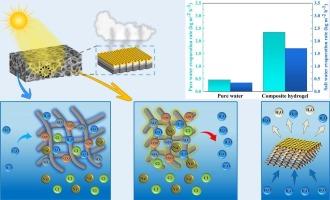Carbon nanotube-enhanced photothermal conversion thermosensitive hydrogel for solar water evaporation: Preparation and performance
IF 5.1
3区 工程技术
Q1 CHEMISTRY, APPLIED
引用次数: 0
Abstract
Harnessing solar photothermal conversion for water evaporation presents an effective approach to addressing freshwater scarcity while minimizing environmental impact. This study employed carbon nanotubes as photothermal conversion materials to design and fabricate a composite thermosensitive hydrogel exhibiting high swelling capacity, excellent salt resistance, and efficient photothermal conversion for solar-driven water evaporation. Furthermore, the effects of carboxylated carbon nanotubes (CNT-COOH) and hydroxylated carbon nanotubes (CNT-OH) on the hydrogel's properties were systematically investigated. Results demonstrate that the composite hydrogel utilizing CNT-COOH as the photothermal conversion material delivered optimal overall performance, exhibiting superior mechanical properties and optimal photothermal conversion capability. It achieved swelling ratios of 385.2 g/g in pure water and 58.3 g/g in saline water, rapidly attaining swelling equilibrium within approximately 200 min. Combined with its thermosensitive property, the material reduces the enthalpy of water evaporation from 2441.5 J/g to 1687.3 J/g. Under 1 kW/m2 solar irradiation, the hydrogel achieved evaporation rates of 2.35 kg m−2 h−1 in pure water and 1.71 kg m−2 h−1 in saline water, both exceeding the theoretical limit of solar water evaporation (1.46 kg m−2 h−1), demonstrating its exceptional evaporation performance. Additionally, the material demonstrated outstanding stability, self-cleaning properties, and salt tolerance during cyclic evaporation testing. This work provides a robust theoretical foundation and technical basis for developing hydrogel evaporators with high salt resistance, high swellability, and long-term durability.

用于太阳能水蒸发的碳纳米管增强光热转换热敏水凝胶:制备与性能
利用太阳能光热转换进行水蒸发是解决淡水短缺的有效方法,同时最大限度地减少对环境的影响。本研究采用碳纳米管作为光热转换材料,设计并制备了一种具有高膨胀能力、优异耐盐性和高效光热转换的复合热敏水凝胶,用于太阳能驱动的水蒸发。此外,系统地研究了羧化碳纳米管(CNT-COOH)和羟基化碳纳米管(CNT-OH)对水凝胶性能的影响。结果表明,以CNT-COOH为光热转化材料的复合水凝胶具有最佳的综合性能,具有优异的力学性能和最佳的光热转化能力。在纯水中的溶胀比为385.2 g/g,在盐水中的溶胀比为58.3 g/g,在约200 min内迅速达到溶胀平衡。结合其热敏特性,该材料将水蒸发焓从2441.5 J/g降低到1687.3 J/g。在1 kW/m2太阳辐照下,水凝胶在纯水中的蒸发速率为2.35 kg m−2 h−1,在咸水中的蒸发速率为1.71 kg m−2 h−1,均超过了太阳能水蒸发的理论极限(1.46 kg m−2 h−1),显示出其优异的蒸发性能。此外,在循环蒸发测试中,该材料表现出出色的稳定性、自清洁性能和耐盐性。为研制高耐盐性、高溶胀性、长期耐用的水凝胶蒸发器提供了坚实的理论基础和技术基础。
本文章由计算机程序翻译,如有差异,请以英文原文为准。
求助全文
约1分钟内获得全文
求助全文
来源期刊

Reactive & Functional Polymers
工程技术-高分子科学
CiteScore
8.90
自引率
5.90%
发文量
259
审稿时长
27 days
期刊介绍:
Reactive & Functional Polymers provides a forum to disseminate original ideas, concepts and developments in the science and technology of polymers with functional groups, which impart specific chemical reactivity or physical, chemical, structural, biological, and pharmacological functionality. The scope covers organic polymers, acting for instance as reagents, catalysts, templates, ion-exchangers, selective sorbents, chelating or antimicrobial agents, drug carriers, sensors, membranes, and hydrogels. This also includes reactive cross-linkable prepolymers and high-performance thermosetting polymers, natural or degradable polymers, conducting polymers, and porous polymers.
Original research articles must contain thorough molecular and material characterization data on synthesis of the above polymers in combination with their applications. Applications include but are not limited to catalysis, water or effluent treatment, separations and recovery, electronics and information storage, energy conversion, encapsulation, or adhesion.
 求助内容:
求助内容: 应助结果提醒方式:
应助结果提醒方式:


